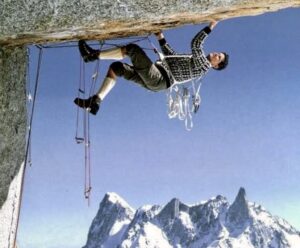This summer, the heart of the Karakorum was not as frozen as expected. Climbers on Gasherbrum II found that the route from Base Camp to Camp 1, over nearly flat glacier terrain, had become a slush bowl. Don Bowie said that he had never seen the glacier in such a condition. “The crevasses were really bad,” he said. Even at night, the temperature didn’t drop enough to let the slush freeze up again. The result was tricky terrain and avalanches at any time of day.
Sergi Mingote, who had summited earlier in the summer, revealed to ExplorersWeb that he had a scary fall in a crevasse on the way to Camp 1. Just days before, on K2, soft, unstable snow above the Bottleneck thwarted the first big summit push.

The glacier leading to Gasherbrum II, seen from Base Camp. Photo: Alex Gavan
This phenomenon, which so affected the climbing season, is not unique to the Karakorum. Since the turn of the century, mountain ranges worldwide have experienced similar patterns. By now, few deny that the earth is becoming warmer, fast. But in the high mountains, in particular, these changes have increased risk and added difficulty.
“The glaciers in all mountains are melting,” Everest guide Garrett Madison told ExplorersWeb. “No ice to climb means more exposed rock, which is dangerous because it’s loose.”

Crossing ladders over open crevasses on Everest’s Khumbu Icefall. Photo: Madison Mountaineering
Nirmal Purja recently cited Ama Dablam, which he climbed in 2014 and 2018, as a further example: “Back in 2014, you could melt snow in Camp 1,” he said. “Last year there was none, and we had to haul large amounts of water from Base Camp. Purja also noticed significant recession of the glaciers on Dhaulagiri as he reached Base Camp last spring.
John All of Western Washington University returned from Lhotse and Everest this spring and told the Associated Press, “The warming temperature is melting the glaciers and the snow around Mount Everest very quickly. Even when there is a storm, it melts in a couple of hours.”
In the Alps, some of the most coveted peaks are literally crumbling as the permafrost melts, making the routes increasingly hazardous. After at least seven people perished on Matterhorn this summer, some guides asked to close the mountain because it was simply too dangerous. No measure was taken this year, but it wouldn’t have been the first time in the last few years that the Matterhorn saw temporary closures due to rockslides. The Eiger, the Dru and the Grandes Jorasses have been likewise affected.

The Matterhorn from Zermatt. Photo: Marcel Wiesweg under Creative Commons CC
Meteorologist Michael Fagin of Everestweather.com pointed out that the same is also happening with US mountains. “Climbers are finding challenging conditions on peaks such as Mt. Rainier and Mt. Baker, because of receding glaciers,” he said. “This results in thinner ice, more sections of exposed rock and open crevasses. The phenomenon is worldwide and has increased in the last 50 years.”
Fagin provides long-and short-range forecasts for many major expeditions. The data he shared shows how precipitation has decreased and average temperatures have increased in mountain ranges around the world.
For example, the North Cascades Glacier Climate Project has been studying the area near Mt. Baker since 1984 and obtained some important results.
Project member Mauri Pelto has taken detailed measurements of 10 glaciers in the North Cascades since he was in college. In that time, he has already seen two glaciers disappear. He also assembled the time-lapse video above, showing Columbia Glacier receding through the years.
“This was put out in 2014 after the very low snowpack,” Fagin noted. “Notice all the years with below-average snowpack since 1988.


Snowfall registered in Mt. Rainier Park.
Meanwhile, in Val D’Aosta in the Italian Alps, snow seasons are getting shorter. “From 1960 to 2017, the alpine snow season [became] 38 days shorter on average, starting 12 days later and closing 26 days earlier,” The Washington Post reported. “The 2015 to 2016 winter season was the warmest on record, with the French Alps [receiving] only 20 percent the normal snowfall, and this year in Val D’Aosta, there was almost no snow at all in February.”
So it is happening. The question is, as climbers, what do we do?
Reassessing risks
Mountain Safety and Risk Management expert Alberto Ayora warns that climbers must adapt to a new situation. A Spanish Army Colonel experienced in Special Ops, Ayora has participated in expeditions to Greenland, Patagonia and the Himalaya. He is now the head of the Safety Committee at the Spanish Mountaineering Federation.
According to Ayora, “places which used to be relatively safe can now be objectively dangerous” because of climate change, he explained.

Alberto Ayora during a recent expedition.
About the Himalaya, he added: “The most significant differences are most noticeable between 4,000m and 6,000m, but the effects are quickly spreading higher and higher.”
“These new conditions,” he concluded, “require a re-assessment of risks.” You can no longer go into an area armed only with information from years before, or approaches that worked in the past.
In other words, higher temperatures are here to stay, and the effects are not going to reverse in the short term. As mountain ecosystems change, it is us climbers who will have to adapt to the new circumstances.
Related story:
The Weather Wizards of the Greater Ranges




